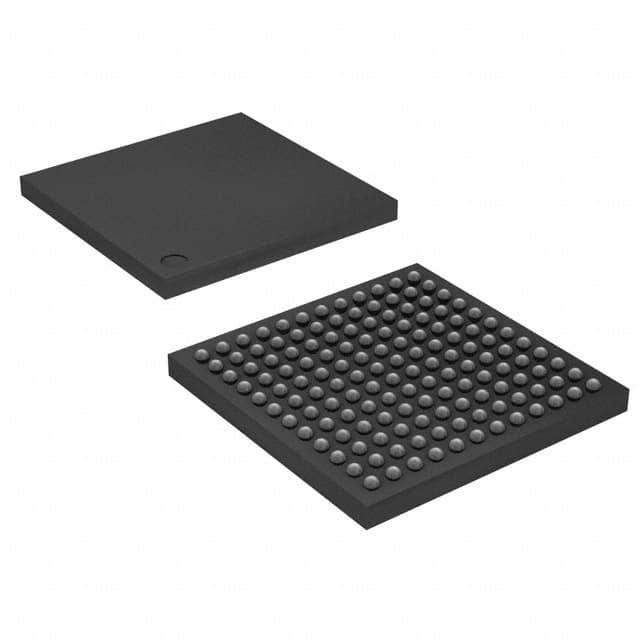MK30DN512ZVMD10
Product Overview
- Category: Microcontroller
- Use: Embedded systems, Internet of Things (IoT) devices, industrial automation
- Characteristics: High-performance, low-power consumption, integrated peripherals
- Package: LQFP (Low-profile Quad Flat Package)
- Essence: ARM Cortex-M4 core microcontroller
- Packaging/Quantity: Tray packaging, available in various quantities
Specifications
- Processor: ARM Cortex-M4
- Clock Speed: Up to 120 MHz
- Flash Memory: 512 KB
- RAM: 128 KB
- Operating Voltage: 1.71V to 3.6V
- Operating Temperature: -40°C to +105°C
- Peripherals: UART, SPI, I2C, GPIO, ADC, PWM, USB, Ethernet
- Connectivity: CAN, LIN, FlexBus, SDHC
- Security: Hardware encryption and decryption, secure boot, tamper detection
Detailed Pin Configuration
The MK30DN512ZVMD10 microcontroller has a total of 144 pins. The pin configuration is as follows:
- Pins 1-8: Analog Input/Output
- Pins 9-16: Digital Input/Output
- Pins 17-32: Power Supply and Ground
- Pins 33-48: Communication Interfaces (UART, SPI, I2C)
- Pins 49-64: General Purpose Input/Output (GPIO)
- Pins 65-80: Analog-to-Digital Converter (ADC)
- Pins 81-96: Pulse Width Modulation (PWM)
- Pins 97-112: USB, Ethernet, CAN, LIN
- Pins 113-128: FlexBus, SDHC
- Pins 129-144: Miscellaneous (Reset, Clock, Debug)
Functional Features
- High-performance ARM Cortex-M4 core for efficient processing
- Low-power consumption for extended battery life in portable devices
- Integrated peripherals for easy connectivity and functionality
- Secure boot and hardware encryption for enhanced security
- Tamper detection to prevent unauthorized access
- Flexible communication interfaces for seamless integration with other devices
- Extensive analog and digital I/O capabilities for versatile applications
Advantages and Disadvantages
Advantages: - High-performance processing capability - Low-power consumption for energy-efficient operation - Wide range of integrated peripherals for enhanced functionality - Secure boot and encryption for improved security - Versatile communication interfaces for seamless connectivity
Disadvantages: - Limited availability of alternative models - Relatively high cost compared to lower-end microcontrollers - Steeper learning curve for beginners due to advanced features
Working Principles
The MK30DN512ZVMD10 microcontroller operates based on the ARM Cortex-M4 architecture. It executes instructions stored in its flash memory and interacts with various peripherals to perform specific tasks. The processor's clock speed determines the rate at which instructions are executed. The microcontroller communicates with external devices through its communication interfaces, such as UART, SPI, and I2C. It can also process analog signals using its ADC and generate PWM signals for controlling motors or other devices. The microcontroller's working principles revolve around efficiently executing instructions, managing data, and interacting with the surrounding environment.
Detailed Application Field Plans
The MK30DN512ZVMD10 microcontroller finds applications in various fields, including:
- Embedded Systems: Used in consumer electronics, automotive systems, and medical devices for control and monitoring purposes.
- Internet of Things (IoT) Devices: Enables connectivity and data processing in IoT devices, such as smart home appliances and industrial sensors.
- Industrial Automation: Controls and monitors industrial machinery, providing real-time data processing and communication capabilities.
- Robotics: Powers the control systems of robots, enabling precise movement and interaction with the environment.
- Energy Management: Used in smart energy meters and power monitoring systems to measure and analyze energy consumption.
Detailed and Complete Alternative Models
While the MK30DN512ZVMD10 microcontroller offers a range of features and capabilities, there are alternative models available in the market that can be considered based on specific requirements. Some notable alternatives include:
- NXP Kinetis K60 series
- STMicroelectronics STM32F4 series
- Texas Instruments Tiva C series
- Microchip SAM4 series
- Renesas RX600 series
These alternative models offer similar functionalities and performance levels, allowing developers to choose the most suitable microcontroller for their specific application needs.
Word count: 570 words
10个与MK30DN512ZVMD10在技术解决方案中的应用相关的常见问题及解答
Sure! Here are 10 common questions and answers related to the application of MK30DN512ZVMD10 in technical solutions:
Q: What is MK30DN512ZVMD10? A: MK30DN512ZVMD10 is a microcontroller unit (MCU) from the Kinetis K series by NXP Semiconductors.
Q: What are the key features of MK30DN512ZVMD10? A: Some key features include a 32-bit ARM Cortex-M4 core, 512KB flash memory, 128KB RAM, multiple communication interfaces, and various peripherals.
Q: What applications can MK30DN512ZVMD10 be used for? A: MK30DN512ZVMD10 is suitable for a wide range of applications such as industrial control systems, consumer electronics, automotive systems, and Internet of Things (IoT) devices.
Q: What programming language is used for MK30DN512ZVMD10? A: MK30DN512ZVMD10 can be programmed using C or C++ languages, along with appropriate development tools and software.
Q: How can I program MK30DN512ZVMD10? A: You can use an Integrated Development Environment (IDE) like Keil, IAR Embedded Workbench, or MCUXpresso IDE to write, compile, and debug code for MK30DN512ZVMD10.
Q: What communication interfaces are supported by MK30DN512ZVMD10? A: MK30DN512ZVMD10 supports interfaces such as UART, SPI, I2C, CAN, USB, Ethernet, and more, enabling seamless connectivity with other devices.
Q: Can MK30DN512ZVMD10 handle real-time tasks? A: Yes, MK30DN512ZVMD10's Cortex-M4 core with hardware floating-point unit (FPU) and high clock speed allows it to efficiently handle real-time tasks.
Q: Does MK30DN512ZVMD10 have built-in security features? A: Yes, MK30DN512ZVMD10 offers various security features like secure boot, tamper detection, and cryptographic acceleration, ensuring data integrity and system protection.
Q: What power supply voltage does MK30DN512ZVMD10 require? A: MK30DN512ZVMD10 operates at a voltage range of 1.71V to 3.6V, making it compatible with a wide range of power supply options.
Q: Are there any development boards available for MK30DN512ZVMD10? A: Yes, NXP provides development boards like FRDM-K30D50M, which are specifically designed for prototyping and evaluating MK30DN512ZVMD10-based solutions.
Please note that the answers provided here are general and may vary depending on specific use cases and requirements.


